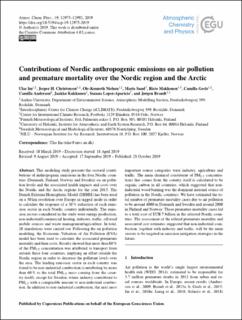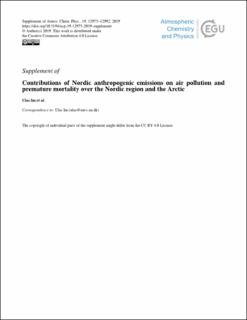| dc.description.abstract | This modeling study presents the sectoral contributions of anthropogenic emissions in the four Nordic countries (Denmark, Finland, Norway and Sweden) on air pollution levels and the associated health impacts and costs over the Nordic and the Arctic regions for the year 2015. The Danish Eulerian Hemispheric Model (DEHM) has been used on a 50 km resolution over Europe in tagged mode in order to calculate the response of a 30 % reduction of each emission sector in each Nordic country individually. The emission sectors considered in the study were energy production, non-industrial/commercial heating, industry, traffic, off-road mobile sources and waste management/agriculture. In total, 28 simulations were carried out. Following the air pollution modeling, the Economic Valuation of Air Pollution (EVA) model has been used to calculate the associated premature mortality and their costs. Results showed that more than 80 % of the PM2.5 concentration was attributed to transport from outside these four countries, implying an effort outside the Nordic region in order to decrease the pollutant levels over the area. The leading emission sector in each country was found to be non-industrial combustion (contributing by more than 60 % to the total PM2.5 mass coming from the country itself), except for Sweden, where industry contributed to PM2.5 with a comparable amount to non-industrial combustion. In addition to non-industrial combustion, the next most important source categories were industry, agriculture and traffic. The main chemical constituent of PM2.5 concentrations that comes from the country itself is calculated to be organic carbon in all countries, which suggested that non-industrial wood burning was the dominant national source of pollution in the Nordic countries. We have estimated the total number of premature mortality cases due to air pollution to be around 4000 in Denmark and Sweden and around 2000 in Finland and Norway. These premature mortality cases led to a total cost of EUR 7 billion in the selected Nordic countries. The assessment of the related premature mortality and associated cost estimates suggested that non-industrial combustion, together with industry and traffic, will be the main sectors to be targeted in emission mitigation strategies in the future. | |

